Guitar World Verdict
After a false start a couple of years back, Chapman’s first UK-made guitar is well considered, beautifully crafted, feels superb and sounds it, too. Currently, there are limited options, but this is the first run and no doubt we’ll see more.
Pros
- +
Excellent build.
- +
Exceptional wood choice.
- +
Neck shape options.
- +
Excellent ‘hot vintage’ pickups.
- +
Hardware.
- +
Fast setup and playability.
Cons
- -
Those fingerboard face inlays lack contrast.
- -
Big leap in price for Chapman.
You can trust Guitar World
Chapman Guitars, headed by internet guitar whizz Rob Chapman (aka the ‘Monkey Lord’ or simply ‘Chappers’), has built a solid and pretty unique place in the worldwide guitar market.
Its modern-aimed, value-for-money instruments are built in Indonesia and Korea, and in many cases have been collaborative designs, spec’d by the brand’s considerable online fanbase.
The company celebrated its 10th anniversary in 2019, and at the tail end of 2022 has chalked up another milestone: its first UK-made guitars. In truth, the idea for these UK builds goes back a few years when a ‘British Standard’ range was announced at the 2018 Winter NAMM show. Unfortunately, this series never made it to market.
The ML1 was the first Chapman design, and rather than being any kind of radical reinvention of the electric guitar it uses a ‘SuperStrat’ platform and sweats the details. The difference here is that, aside from being made in the UK, there’s no corner-cutting in terms of build or parts to meet a lower price point as with the existing Asian-made Chapman ranges.
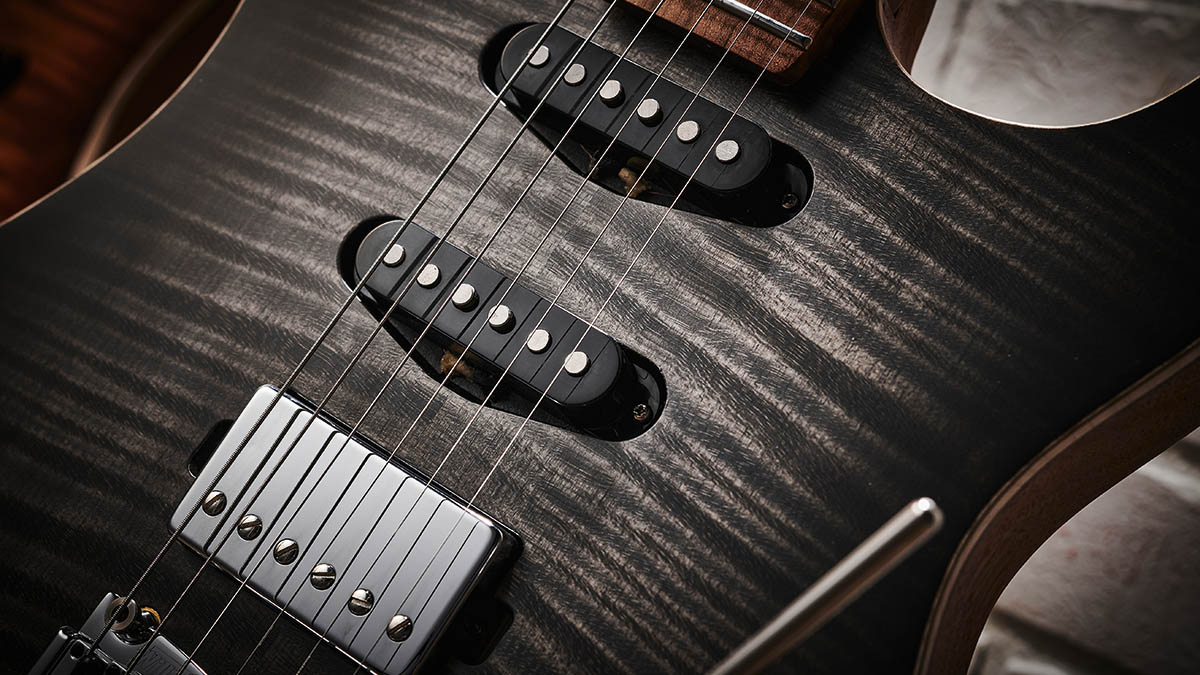
Coined the Workshop Series, this new vision of the ML1 is basically one design with two neck options: a roasted bird’s eye maple neck with a 356mm (14-inch) fingerboard radius and an ‘oval C/soft D’ neck profile option, or a roasted flamed maple neck with a 305mm (12-inch) fingerboard radius and an ‘C shape’ neck profile.
The top wood can be spec’d with either flame or quilted maple, and while the neck, body back and sides are in a standard satin nitro finish, the tops can be satin or gloss and come in a pretty wide colour choice.
Aside from those relatively subtle differences, the ML1 has a fixed specification and is built to the same uncompromising standards of the other UKGB instruments we’ve evaluated such as PJD, Cream T and Seth Baccus: the craft is superb. The ML1 uses an African mahogany body, which is two-piece quarter-sawn on one of our samples, slightly rift-sawn on the other – either way, very similar.
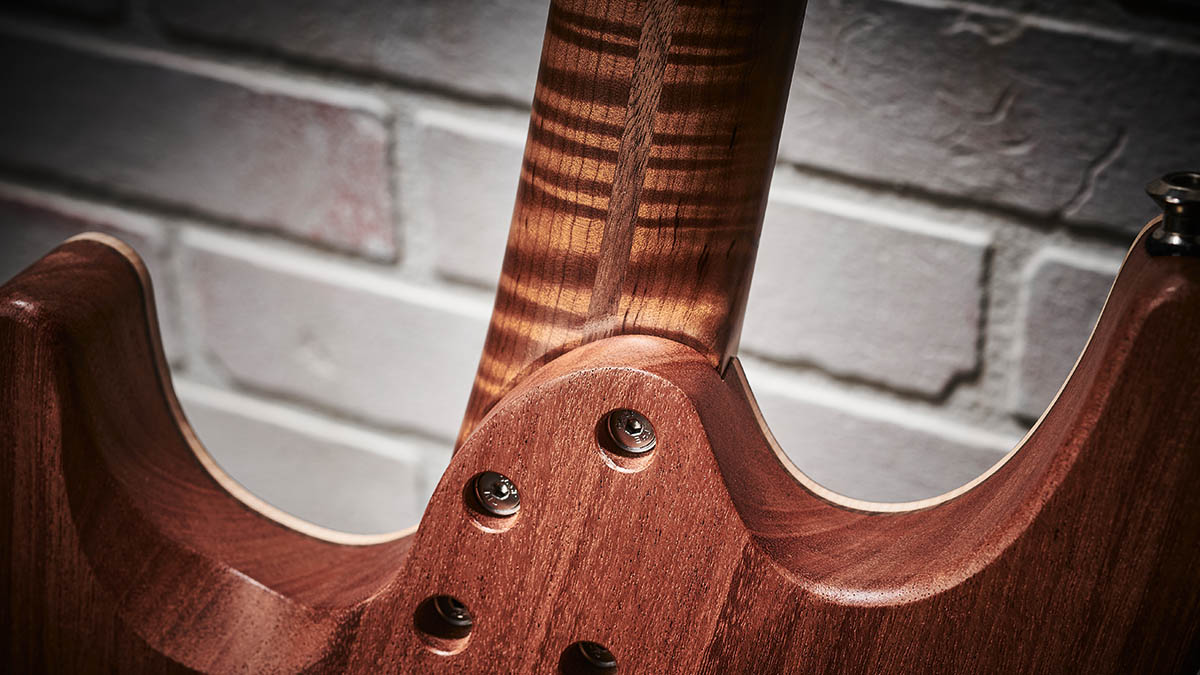
To keep the weight in check it’s lightly chambered, primarily on the ‘wings’ and behind the vibrato. The structure is sealed by a 5mm thin maple top with a thinner walnut ‘sandwich filler’ that’s clearly visible under the natural edge faux binding of the coloured maple top.
This creates an overall thickness of 44mm. The ultra-thin finish leaves nowhere to hide in terms of craft, and the natural mahogany is left lightly open-pored, contrasting the silkier-to-the touch maple top and neck.
And what a neck it is. Just like the heavily flamed maple neck we saw on the UKGB-made Seth Baccus Shoreline, the flame maple neck here on one of our samples is equally gorgeous with a honeyed caramel hue and vivid flame that moves in the light.
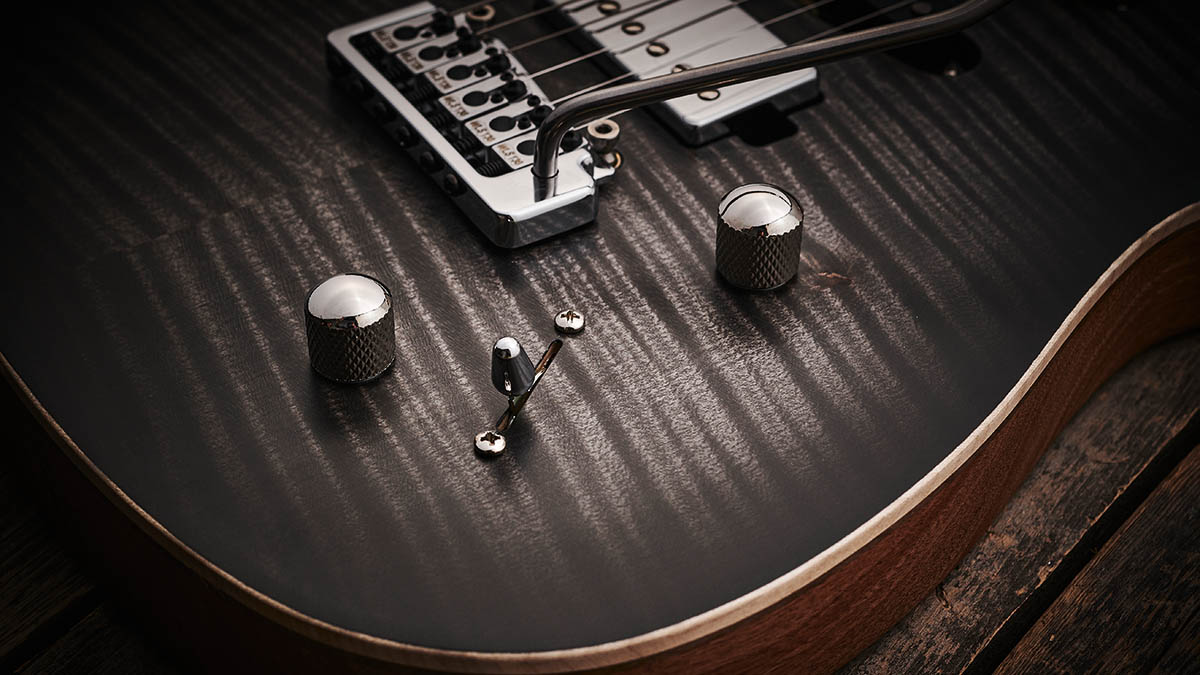
Our other slightly lighter-coloured sample looks almost painterly in comparison: the bird’s eye flecks are beautiful and a perfect foil for the dappled quilt-maple glossed top. Like PJD’s guitars, the neck fixings are actual bolts that screw into threaded inserts in the neck itself – rather than the usual screws of most so-called ‘bolt-ons’.
The ML1 has a fixed spec and is built to UKGB’s uncompromising standards – superb
The fingerboard is a separate piece of the same material and therefore doesn’t actually need the walnut skunk stripe on the back; the double-action truss rod is installed from the front face of the neck and covered with the fingerboard. Another slight anomaly with the design are the ‘doughnut’ fingerboard face inlays that appear to be an outer circle of walnut with a maple centre.
They supply little contrast, especially on the slightly darker flame maple neck, and with the guitar strapped on they virtually disappear, so it’s rather handy that we have those glow-in-the-dark side dots.
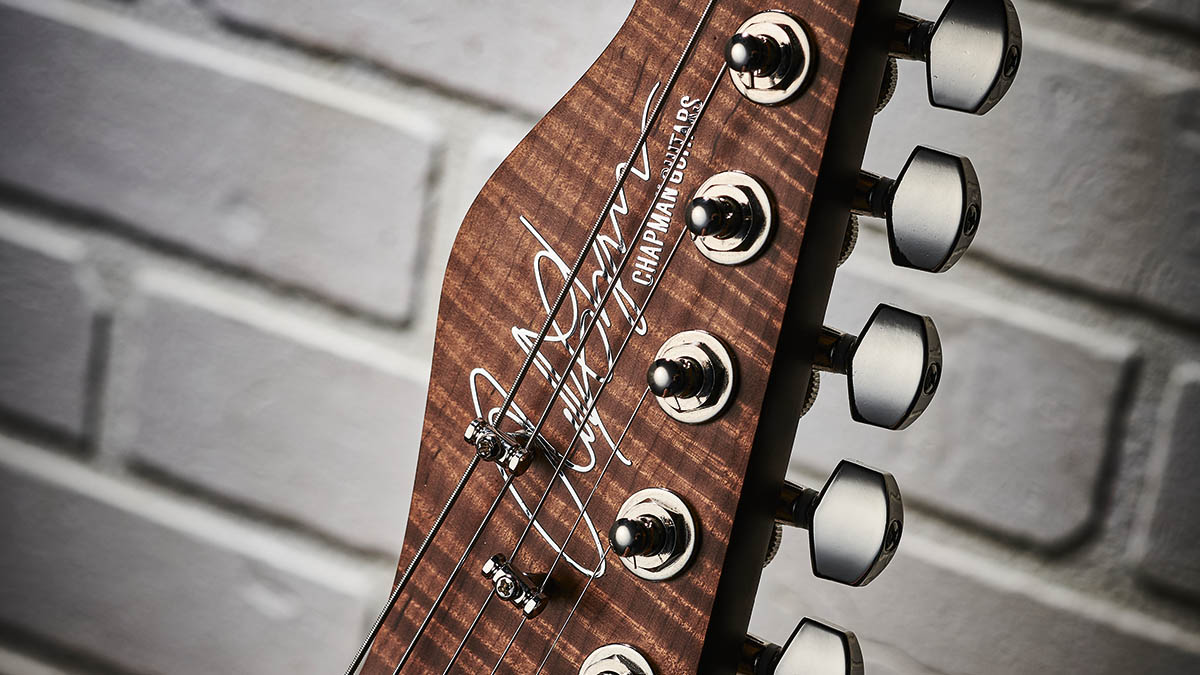
If the craft appears high level then it’s matched by the hardware and parts. The Chapman-spec’d Wilkinson vibrato (with a lengthy WVP130 ‘R’ ‘CG’ name) is based on the R Series WVPSR with the addition of the very well-received WLS130 locking saddles (as used by Suhr).
The steel block has staggered, deep-drilled holes and the ‘Wave 2’ pivot. Then we have a push-in-and-screw arm with tension adjustment. It’s a finely conceived and well-engineered system that includes a slippery bone nut and Hipshot Grip-Lock open tuners.
The pickups are custom designed for this guitar by the UK’s Cream T, paired with a straightforward drive from the five-way lever switch and master volume and tone controls.
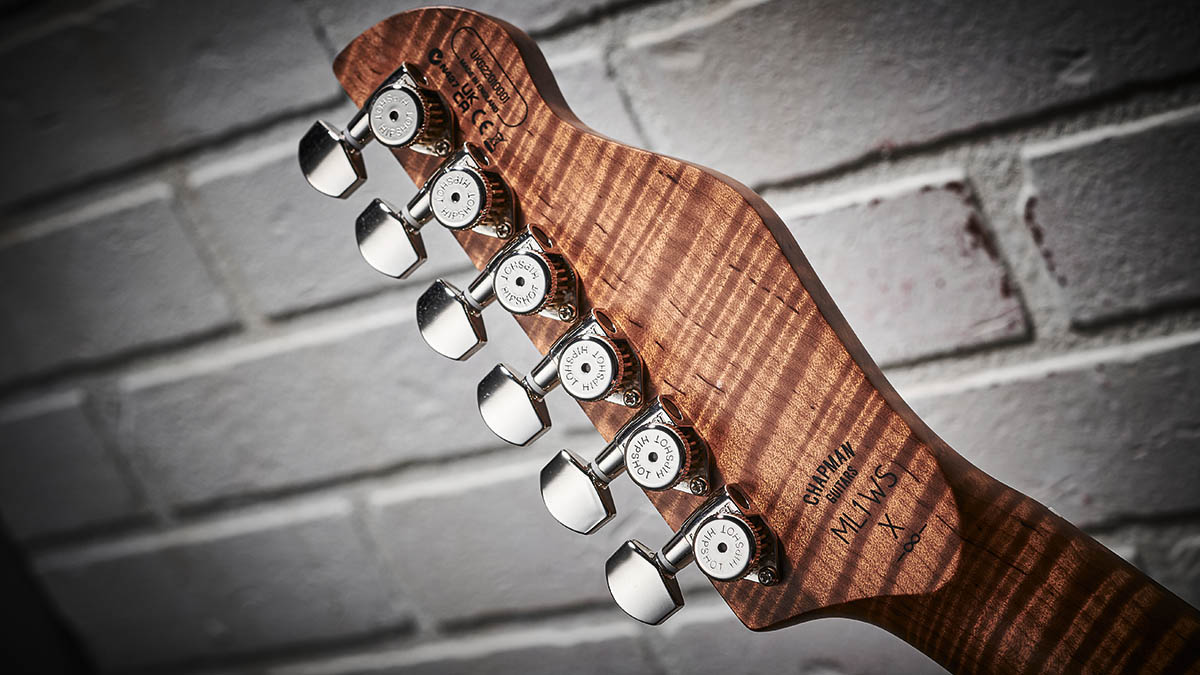
Feel & Sounds
Despite the gloss top of our quilted-front review sample, the ML1 feels almost unfinished. The silky feel of the neck back feels superb in the hand, meaning the guitar doesn’t get in the way of the important bit: your playing.
Both our review samples are set pretty low. Our quilt-top model has virtually zero relief and a string height of just over 1mm on the treble side, 1.27mm on the bass side. There’s a touch more relief on the flame-top sample, which slightly raises the action height to 1.27mm on the treble side and 1.5mm on the bass.
And while the ‘oval C/soft D’ profile feels to have a fuller shoulder than the ‘soft C’ profile, the widths and depths are very close: the ‘oval C/soft D’ neck is slightly wider at the nut at 42.36mm and 52.5mm by the 12th compared to the 42.1mm nut/52mm at the 12th width of the ‘soft C’. In terms of depth, both measure 21.65mm at the 1st fret; the ‘soft C’ neck is slightly fuller by the 12th fret at 23.2mm and the ‘oval C/soft D’ measures 22.6mm.
The difference between the fingerboard radiuses is really minimal, while the fret gauge is pretty big (measuring 2.76mm wide and 1.4mm high), making it great for easy bends, hammer-ons and pull-offs. The stainless-steel fretwire is super smooth, too, and, put simply, both are excellent players, with nice incurving fretboards sides that have quite heavily rolled edges.
Despite the locking saddles and tuners and a superbly cut nut, the reverse headstock brings its own subtle spin – and don’t forget you need to stretch your strings behind the nut, too, not least that long ‘dead’ string on the low E, to get things 100 per cent in tune. Mind you, is any vibrato ‘100 per cent’ in tune? That’s a discussion for another day. We’ll just say that these are beautifully in-tune guitars.
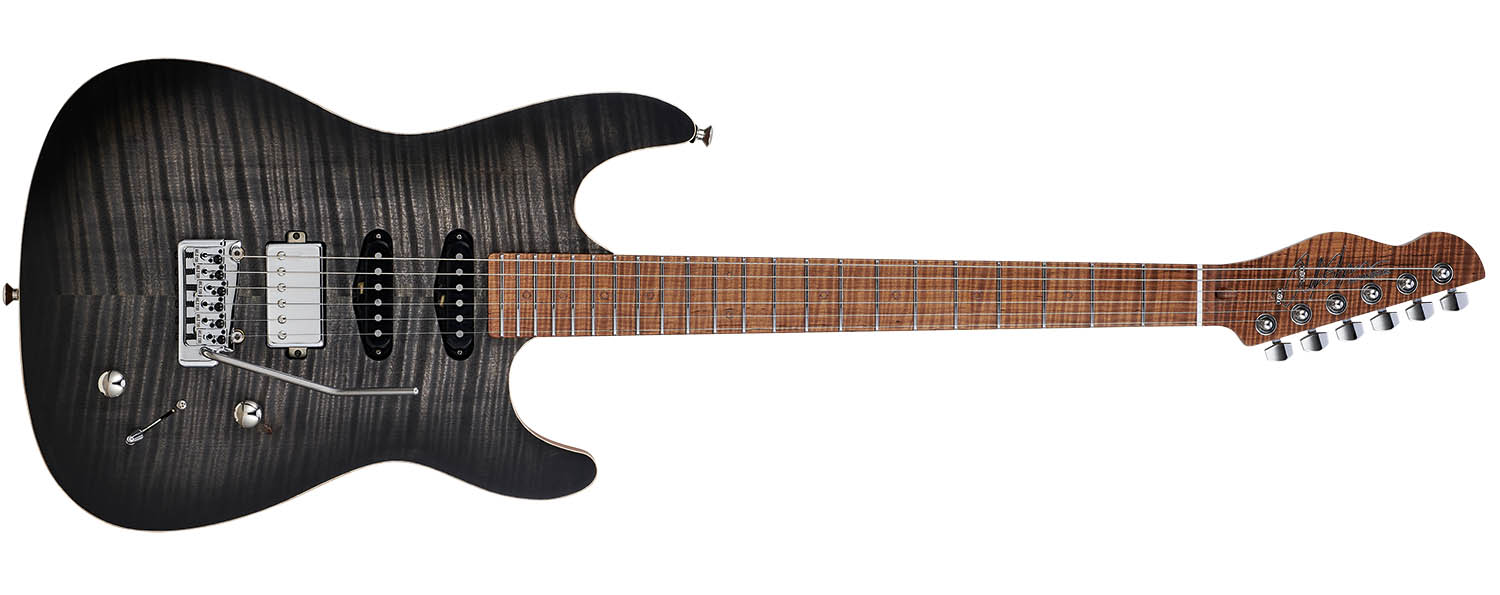
Rather like the roosty, woody vibe of the all-stain finished sample we have to evaluate, the sounds are a perfect match. To be honest, this could just feature the neck and bridge with a three-way switch for many players.
The woody sparkle of the neck single coil covers so much ground and it’s perfectly contrasted by the bridge, which sounds like a slightly overwound PAF with a bit of kick, a little rounding of the highs.
Of course, we also have some deliciously funky (and hum-cancelling) mixes with a strong mid-placed single coil that has a little grunt to it compared with the neck. Some players might miss some wiring tricks, but, really, we’re not sure you’d want to mess with sounds as strong as these.
Verdict
After a false start a couple of years back, Chapman’s first UK-made guitar is well considered, beautifully crafted, feels superb and sounds it, too. Currently, there are limited options, but this is the first run and no doubt we’ll see more.
It’s not really bringing anything new to the table in terms of design – and could be seen as an homage to the likes of Tom Anderson’s long-running and pioneering style – but it feels so familiar and comfortable, that’s hardly a criticism. With such a strong beginning we can only predict good things for the future of what is simply great guitar craft.
Specs
- PRICE: £3,499 (inc case)
- ORIGIN: UK
- TYPE: Double-cutaway, lightly chambered electric guitar
- BODY: African mahogany (chambered)
back w/ walnut pin-stripe, 5mm thick flame maple ‘drop’ top - NECK: Roasted flame maple, ‘C shape’, profile, bolt-on
- SCALE LENGTH: 648mm (25.5”)
- NUT/WIDTH: Bone/42.1mm
- FINGERBOARD: Roasted flame maple, small ‘doughnut’ inlays, 305 (12”) radius, glow-in the‑dark side dots
- FRETS: 22, jumbo stainless steel (Jescar)
- HARDWARE: ‘Bespoke for Chapman’ Wilkinson WVP130 ‘R’ ‘CG’ vibrato with steel block and steel locking saddles; Hipshot Grip-Lock 18:1 ratio locking tuners – nickel-plated
- STRING SPACING, BRIDGE: 53.5mm
- ELECTRICS: Chapman Carnyx (by Cream T) HSS set, 5-way lever pickup selector switch, master volume and tone
- WEIGHT (kg/lb): 3.33/7.33
- OPTIONS: Roasted bird’s eye maple neck with ‘oval C/ soft D’ profile and 356mm (14”) radius fingerboard. Flame or quilted maple drop top
- RANGE OPTIONS: No
- LEFT HANDERS: No
- FINISH: Satin nitro to neck and body (back and sides), satin or gloss nitro to top
- CONTACT: Chapman Guitars

Dave Burrluck is one of the world’s most experienced guitar journalists, who started writing back in the '80s for International Musician and Recording World, co-founded The Guitar Magazine and has been the Gear Reviews Editor of Guitarist magazine for the past two decades. Along the way, Dave has been the sole author of The PRS Guitar Book and The Player's Guide to Guitar Maintenance as well as contributing to numerous other books on the electric guitar. Dave is an active gigging and recording musician and still finds time to make, repair and mod guitars, not least for Guitarist’s The Mod Squad.
“What blew me away was that everyone wanted the curly maple top. People were calling, saying, ‘I’ve got to have the bird inlays’”: Paul Reed Smith on raising the Standard 24, finally cracking the noise-free guitar and why John Sykes is a tone hero
“It combines unique aesthetics with modern playability and impressive tone, creating a Firebird unlike any I’ve had the pleasure of playing before”: Gibson Firebird Platypus review











